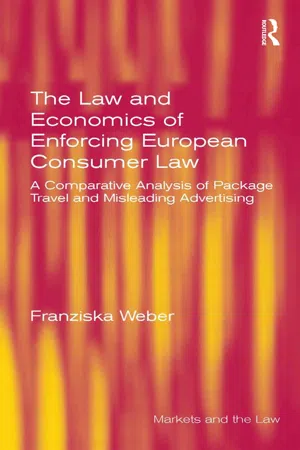
The Law and Economics of Enforcing European Consumer Law
A Comparative Analysis of Package Travel and Misleading Advertising
- 336 pages
- English
- ePUB (mobile friendly)
- Available on iOS & Android
The Law and Economics of Enforcing European Consumer Law
A Comparative Analysis of Package Travel and Misleading Advertising
About this book
In the internet age, the need for effective consumer law enforcement has arguably never been greater. This timely book is a comparative law and economic analysis of the changing landscape of EU consumer law enforcement policy. EU member states are moving away from purely public or private law enforcement and now appear to be moving towards a more mixed approach, not least due to European legislation. This book reflects on the need for and creation of efficient enforcement designs. It examines the various economic factors according to which the efficiency of different enforcement mechanisms can be assessed. Hypothetical case scenarios within package travel and misleading advertising, dealing with substantial individual harm and trifling and widespread harm are used to illustrate various consumer law problems. Design suggestions on how to optimally mix enforcement mechanisms for these case scenarios are developed. The findings are then used as a benchmark to assess real life situations in countries with different enforcement traditions - the Netherlands, Sweden and England. The book is of value to both researchers and policy-makers working in the area of consumer protection.
Frequently asked questions
- Essential is ideal for learners and professionals who enjoy exploring a wide range of subjects. Access the Essential Library with 800,000+ trusted titles and best-sellers across business, personal growth, and the humanities. Includes unlimited reading time and Standard Read Aloud voice.
- Complete: Perfect for advanced learners and researchers needing full, unrestricted access. Unlock 1.4M+ books across hundreds of subjects, including academic and specialized titles. The Complete Plan also includes advanced features like Premium Read Aloud and Research Assistant.
Please note we cannot support devices running on iOS 13 and Android 7 or earlier. Learn more about using the app.
Information
1 Introduction
Context: The Need for Consumer Protection Laws and their Enforcement
Table of contents
- Cover Page
- Half Title Page
- Title Page
- Copyright Page
- Table of Contents
- List of Cases
- List of Legislation
- List of Abbreviations
- Foreword
- Preface
- 1 Introduction
- Part I Optimal Enforcement Mixes (Analysis)
- Part II Country Studies (Comparison)
- Part III Conclusions
- Bibliography
- Index